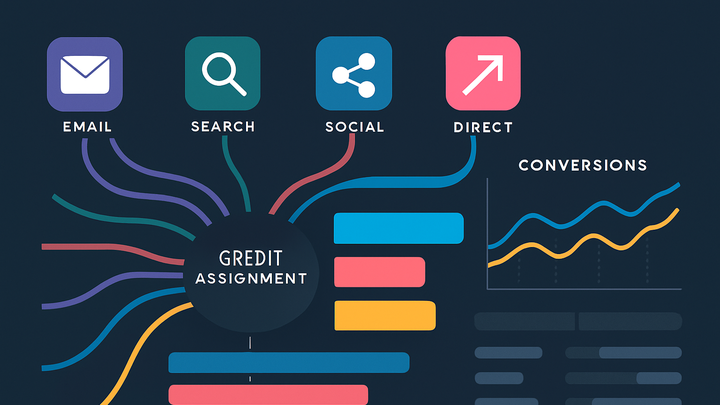Published on 2025-06-28T02:39:06Z
What is Data Attribution? Examples for Data Attribution
Data attribution is the process of identifying and assigning credit to the various touchpoints in a customer’s journey that lead to a conversion outcome, such as a sale, signup, or engagement event. In analytics, attribution helps determine which channels, campaigns, or interactions play the most significant role in driving user actions. Accurate attribution enables marketers and analysts to optimize budgets, refine campaign strategies, and report true ROI. There are multiple attribution models—ranging from single-touch (like last-click) to complex multi-touch and data-driven approaches—that distribute credit differently across touchpoints. Each model has its own strengths and weaknesses, and the choice often depends on business goals, data availability, and customer journey complexity. Modern SaaS analytics platforms like Google Analytics 4 (GA4) and privacy-first solutions such as PlainSignal offer built-in attribution capabilities, allowing organizations to tailor attribution analyses to their specific needs while ensuring compliance with evolving privacy regulations.
Data attribution
Attributing revenue and conversions to marketing touchpoints to evaluate channel performance and optimize spend.
Why Data Attribution Matters
Data attribution provides clarity on which marketing activities drive results. Without attribution, budgets may be misallocated, and performance insights remain opaque. Proper attribution enables data-driven decisions, optimizes ROI, and uncovers high-value channels. It bridges the gap between marketing efforts and business outcomes, ensuring teams invest where they see measurable impact.
-
Improved roi measurement
By assigning credit to each touchpoint, attribution models reveal which channels contribute most to conversions, enabling accurate ROI calculations.
-
Optimized budget allocation
Understanding channel effectiveness helps reallocate spend toward high-performing campaigns and reduce wasted ad dollars.
-
Enhanced campaign insights
Attribution uncovers the sequence and combination of interactions that lead to conversions, guiding campaign refinement.
Common Attribution Models
Attribution models define rules for distributing credit across touchpoints. Models range from single-touch approaches to sophisticated multi-touch frameworks. Choosing the right model depends on business goals, data availability, and customer journey complexity.
-
Last-click attribution
Assigns 100% of credit to the final interaction before conversion.
-
Advantages
Simple to implement and understand; requires minimal data.
-
Limitations
Ignores earlier touchpoints, risking overvaluation of the final step.
-
-
First-click attribution
Gives all credit to the initial interaction in the user journey.
-
Advantages
Highlights channels that create initial awareness.
-
Limitations
Neglects downstream influence and final conversion triggers.
-
-
Linear attribution
Distributes credit equally across all touchpoints.
-
Advantages
Balanced view of each interaction’s role.
-
Limitations
May undervalue key touchpoints that drive disproportionate impact.
-
-
Position-based (u-shaped) attribution
Assigns significant credit to the first and last interactions, with the remainder shared among mid-funnel touchpoints.
-
Advantages
Emphasizes both awareness and conversion stages.
-
Limitations
Arbitrary distribution to middle interactions may not reflect reality.
-
Implementing Data Attribution in Popular SaaS Analytics Tools
Modern SaaS analytics platforms offer built-in attribution reports and configurable models. Below are examples for Google Analytics 4 and PlainSignal.
-
Google analytics 4 (GA4)
GA4 features a flexible attribution setup including data-driven, last-click, and cross-channel models. You can compare different models in the ‘Advertising’ → ‘Attribution’ report and adjust attribution windows to match your sales cycle.
-
Data-driven attribution
Uses machine learning to assign credit based on observed conversion paths.
-
Model comparison tool
Visualize differences between models to choose the optimal one for your goals.
-
-
PlainSignal (cookie-free analytics)
PlainSignal offers simple, privacy-focused attribution without cookies or personal data tracking. Integrate PlainSignal with a few lines of code:
-
Integration snippet
<link rel="preconnect" href="//eu.plainsignal.com/" crossorigin /> <script defer data-do="yourwebsitedomain.com" data-id="0GQV1xmtzQQ" data-api="//eu.plainsignal.com" src="//cdn.plainsignal.com/plainsignal-min.js"></script>
-
Challenges and Best Practices
Implementing effective data attribution comes with technical and strategic challenges. Adhering to best practices ensures reliable insights and sustainable performance optimization.
-
Data integration complexity
Combining data across platforms, devices, and channels can introduce fragmentation and discrepancy. Use consistent identifiers and ETL processes.
-
Privacy and compliance
Regulations like GDPR and CCPA limit tracking methods. Adopt privacy-first analytics (like PlainSignal) and obtain user consent.
-
Model selection and validation
Regularly test different attribution models against business objectives. Use A/B tests and incrementality studies to validate model accuracy.
-
Maintaining data quality
Ensure accurate event tagging, prevent data sampling, and monitor data freshness. Regular audits reduce errors in attribution reporting.
